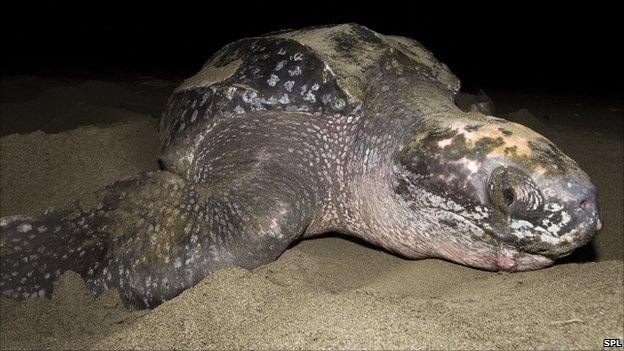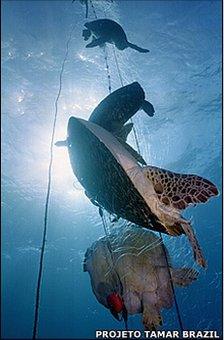Leatherback turtles tracked on Atlantic 'danger' trips
- Published

The tagged South Atlantic leatherbacks head back to the same Gabon beaches to mate
Scientists have for the first time tracked leatherback turtles from the world's largest nesting site, in Gabon, as they traverse the South Atlantic.
Data from tags on their backs show they swim thousands of kilometres each year.
These journeys take them through areas where they are at high risk of being caught accidentally by fishing boats.
The leatherback is the world's biggest turtle and listed as Critically Endangered, largely because of poaching for eggs and snaring in fishing gear.
Typically between one and two metres long, the animals weigh up to three-quarters of a tonne and can swim across entire oceans, returning to their ancestral nesting sites to breed every few years.
First tracks
Writing in the Royal Society journal Proceedings B, external, an international group of researchers relate how they tagged 25 adult female leatherbacks (Dermochelys coriacea) from Gabon over a four-year period.
The Gabon nesting sites were identified in 2009 as the world's biggest, supporting an estimated population of 15-41,000 females.

Accidental catching in fishing gear is a major source of turtle mortality
"The reason for doing the project is to understand the turtles' movements, but the context is that the Pacific population recently went through a huge decline," said Matthew Witt from Exeter University, the study's lead author.
"Part of the reason for that is interaction with fisheries - so it seemed very pertinent to get a better understanding of what the South Atlantic leatherbacks are up to."
A study published last year estimated that millions of turtles had been killed in fishing gear over the last 20 years.
Although leatherbacks have been extensively tracked further north in the Atlantic and also in the Pacific, this is the first time that more than a few animals have been followed from the South Atlantic.
The tags affixed to the turtles' backs typically functioned for several months before either falling off, succumbing to battery failure or becoming clogged with seaweed so they refused to return data.
The South Atlantic leatherbacks adopted three different patterns.
Some swam west and remained in the tropical Atlantic waters. A second group swam south-west until they reached the coast of South America, and foraged in shallow waters there; while the remainder moved southwards down the western coast of Africa.
Why they should take these different routes is not clear.
But as hatchlings, they swim weakly and must go where the South Atlantic gyre sweeps them; and the scientists suspect that as adults, each turtle sticks with the path it took on its initial, involuntary foray.
Catching the drift
The global population of leatherbacks is not known, although estimates based mainly on data from nesting sites suggest a decline of up to 80% between 1982 and 1996.
In Malaysia, a site that had once supported 10,000 females contained just 37 in 1995.
Conservation initiatives appear to have halted the decline in some sites.
Egg-poaching does not appear to be a major threat in Gabon, where about 80% of the nesting areas lie inside National Parks.
But fishing could be. The turtles' routes take them through areas traversed by long-line fishing boats, which are known to catch turtles, and into coastal waters where entrapment in gillnets is a demonstrable threat.
The scientists calculate that the South Atlantic turtles travel the territorial waters of at least 11 nations - although the bulk of their time is spent in open ocean, where there are very few rules on fishing.
"This study gives us a really good idea where we should be focussing efforts to reduce bycatch," Dr Witt told BBC News.
"Over the last five or 10 years there's been quite a lot of research for example on using a different shape of fish hook that cuts the rate of unintentional catch for things like turtles while maintaining the intentional rate of fish catch.
"So I think we now need to push forward and say 'let's change all the hooks in these areas'."
- Published29 October 2010